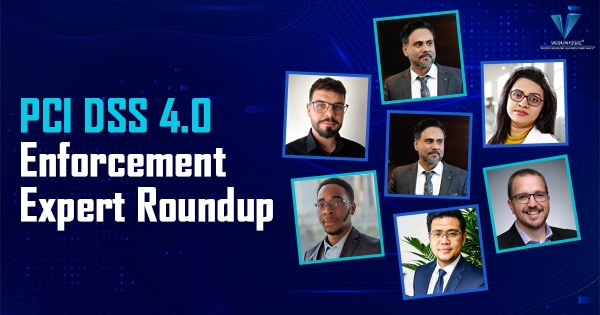Last Updated on November 19, 2025 by Narendra Sahoo
As PCI DSS 4.0 moves closer to full enforcement in 2025, many businesses are still trying to separate what truly matters from the noise. The new version introduces a stronger security mindset, more flexible implementation options and a greater emphasis on continuous monitoring. For many organizations, the challenge is not understanding the requirements but knowing where to begin.
To bring clarity, we reached out to industry professionals who work closely with payment security every day. Their practical views highlight the steps companies can take immediately, even before the transition deadlines arrive. From strengthening access controls to rethinking documentation and improving internal security processes, these expert insights offer a grounded and realistic path that organizations of all sizes can follow.
1.Kyle Hinterberg :

Role: PCI DSS Expert | Sr. Manager at LBMC.
Country: United States
Social Media: Linkedin
Expert Opinion:
The most practical thing any entity can do is to make sure they understand their scope. Requirement 12.5.2 makes this a necessity, but it’s also the only way to make sure you are protecting what matters. Especially with the new requirements, which some organizations are still in the process of implementing, it’s critical to understand where they need to be implemented. Otherwise they may purchase tools or implement processes which may ultimately be unnecessary or incomplete.
2.Andrei Gliga:

Country : Romania
Social Media:LinkedIn
Expert Opinion:
For companies that are new to PCI DSS, the most practical step is to set up the foundation for everything else:
– map, as clear and comprehensive as possible, the data flows and network connections.
– prepare the inventory of the system components that are involved in the transfer, storage, or processing of account data, or securing the other system components. Think endpoints, networks, cloud services, security software.
– register all third parties providing software and platforms (especially cloud services) on which the product relies to function. Understand where their responsibilities end and where yours begin.
These may often seem like bureaucratic burdens but are in fact essential in delimiting the responsibilities and possibly the actual scope, saving company time and money.
3.Syed Sherazi

Role: Cybersecurity & IT Consultant At Ez Tech Solution LLC .
Country: United States
Social Media: LinkedIn
Expert Opinion:
One of the most practical steps companies can take right now is to perform a detailed gap assessment against PCI DSS 4.0 requirements. Most organizations still underestimate the effort needed for continuous monitoring and evidence collection, so building those processes early makes compliance smoother. Standardizing policies, hardening controls, and training staff now will save a lot of pressure before enforcement in 2025.
4.Oneil Dixon

Country: United Kingdom
Social Media: LinkedIn
Expert Opinion:
To prepare for PCI DSS 4.0, companies should start with a gap analysis. This requires reviewing existing controls, policies and processes to identify where they do not meet the updated requirements, particularly for MFA, encryption and the new customised approaches, allowing them to strengthen their security and ensure compliance.
5.Ronilo C. L

Role: Security |Fraud Detection Prevention and Awareness
Country: Philippines
Social Media: LinkedIn
Expert Opinion:
The most critical step for PCI DSS 4.0 isn’t just encrypting data or updating policies—it’s conducting a targeted Gap Analysis of your entire Cardholder Data Environment.
Why? This isn’t just an assessment; it’s the actionable roadmap you need. It immediately:
Reveals the Gap: Shows the real distance between v3.2.1 and the 60+ new requirements in v4.0.
Justifies Budget: Creates a prioritized list of projects to secure funding and resources for 2024.
Unlocks Strategy: Identifies where the new “Customized Approach” can turn your existing security controls into a competitive advantage.
Don’t treat this as a casual audit. Engage an expert, focus on the new 4.0 requirements, and demand a Prioritized Remediation Roadmap as the output. This is how you transform a compliance deadline into a managed security program.
6.Urmila Kandha

Role: Risk Manager | Internal Auditor| Enterprise Agile Coach | TEDx Speaker
Country: India
Social Media: LinkedIn
Expert Opinion:
The most important step companies should take to prepare for PCI DSS 4.0 enforcement is to conduct a thorough gap analysis against the new requirements. This helps identify security gaps and prioritize remediation efforts to achieve compliance efficiently. Starting early ensures readiness for 2025 enforcement.
7. Narendra Sahoo

Role : Director (PCI QSA, PCI QPA, CISSP, CISA, SLCA, SSFA and CRISC) @ VISTA InfoSec
Country: India
Social Media: LinkedIn
Expert Opinion:
First thing that needs to be done is get proper scoping of all the people, process and technologies involved in card processing OR storage OR transmission, your vendors, IDC, everything. You need to keep in mind that like ISO standards, scope is not a choice, all touchpoints of card in your environment is the Active scope. Once that is done, you can take some expert advice on whether this “Scope” can be reduced using various strategies such as Network Segregation, masking, etc. Once that is done, then the Gap Analysis to let you know as to what the shortcomings are between the PCI DSS requirements and your setup.
Narendra Sahoo (PCI QPA, PCI QSA, PCI SSF ASSESSOR, CISSP, CISA, CRISC, 27001 LA) is the Founder and Director of VISTA InfoSec, a global Information Security Consulting firm, based in the US, Singapore & India. Mr. Sahoo holds more than 25 years of experience in the IT Industry, with expertise in Information Risk Consulting, Assessment, & Compliance services. VISTA InfoSec specializes in Information Security audit, consulting and certification services which include GDPR, HIPAA, CCPA, NESA, MAS-TRM, PCI DSS Compliance & Audit, PCI PIN, SOC2 Compliance & Audit, PDPA, PDPB to name a few. The company has for years (since 2004) worked with organizations across the globe to address the Regulatory and Information Security challenges in their industry. VISTA InfoSec has been instrumental in helping top multinational companies achieve compliance and secure their IT infrastructure.




